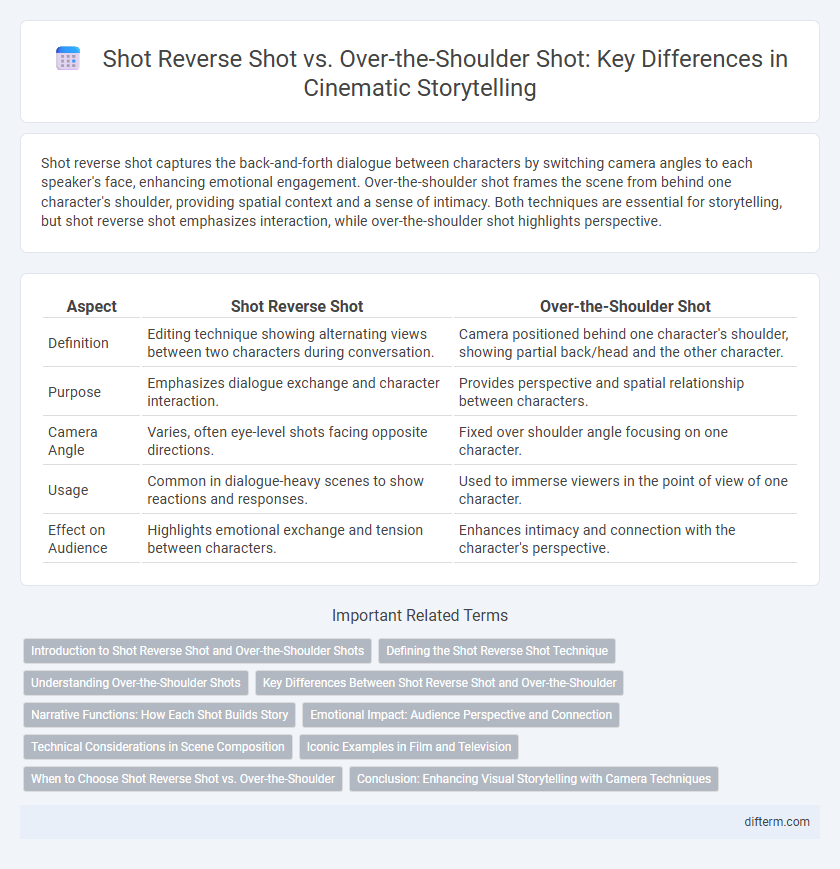Shot reverse shot captures the back-and-forth dialogue between characters by switching camera angles to each speaker's face, enhancing emotional engagement. Over-the-shoulder shot frames the scene from behind one character's shoulder, providing spatial context and a sense of intimacy. Both techniques are essential for storytelling, but shot reverse shot emphasizes interaction, while over-the-shoulder shot highlights perspective.
Table of Comparison
| Aspect | Shot Reverse Shot | Over-the-Shoulder Shot |
|---|---|---|
| Definition | Editing technique showing alternating views between two characters during conversation. | Camera positioned behind one character's shoulder, showing partial back/head and the other character. |
| Purpose | Emphasizes dialogue exchange and character interaction. | Provides perspective and spatial relationship between characters. |
| Camera Angle | Varies, often eye-level shots facing opposite directions. | Fixed over shoulder angle focusing on one character. |
| Usage | Common in dialogue-heavy scenes to show reactions and responses. | Used to immerse viewers in the point of view of one character. |
| Effect on Audience | Highlights emotional exchange and tension between characters. | Enhances intimacy and connection with the character's perspective. |
Introduction to Shot Reverse Shot and Over-the-Shoulder Shots
Shot reverse shot is a fundamental cinematic technique used to depict conversations by alternating between two characters' perspectives, enhancing viewer engagement through visual dialogue flow. Over-the-shoulder shots frame one character's shoulder and back of the head to establish spatial relationships and context within interactions. Both techniques are essential for creating dynamic, immersive storytelling in film and television.
Defining the Shot Reverse Shot Technique
The shot reverse shot technique involves alternating camera angles between two characters, typically during a conversation, to capture each person's perspective. This method enhances viewer engagement by emphasizing reactions and dialogue exchanges, often using close-ups or medium shots. Distinct from the over-the-shoulder shot, shot reverse shot does not always include the visible shoulder or back of the frame to maintain focus on individual expressions.
Understanding Over-the-Shoulder Shots
Over-the-shoulder shots frame a character's perspective by capturing the back of their head and shoulder while focusing on the subject they are interacting with, enhancing spatial relationships and emotional connections in dialogue scenes. This technique differs from shot reverse shot, which alternates angles between characters to depict a conversation dynamically but lacks the intimate viewpoint provided by over-the-shoulder shots. Filmmakers use over-the-shoulder framing to immerse the audience in the character's point of view, making interactions more engaging and visually cohesive.
Key Differences Between Shot Reverse Shot and Over-the-Shoulder
Shot reverse shot alternates between two characters' perspectives, primarily used to depict dialogue and reactions, creating a conversational rhythm. Over-the-shoulder (OTS) shot frames one character's shoulder and head in the foreground while focusing on the other character in the background, establishing spatial relationships and point of view. Key differences lie in shot composition and purpose: shot reverse shot emphasizes back-and-forth interaction, whereas OTS shot provides visual context and perspective within the scene.
Narrative Functions: How Each Shot Builds Story
Shot reverse shot enhances narrative by showcasing direct dialogue and emotional exchanges between characters, emphasizing their reactions and intimacy. Over-the-shoulder shots create spatial orientation and perspective, situating viewers within the conversation's physical environment and establishing relational dynamics. Combined, these techniques strengthen storytelling by balancing character focus with contextual setting, deepening audience engagement.
Emotional Impact: Audience Perspective and Connection
Shot reverse shot enhances emotional impact by capturing intimate reactions between characters, allowing the audience to deeply connect with their feelings through close-up expressions and eye lines. Over-the-shoulder shots provide a contextual perspective that situates viewers within the scene, offering a sense of involvement and alignment with a character's point of view. Combining these techniques strategically intensifies audience engagement, balancing personal emotional insight with spatial awareness in cinematic storytelling.
Technical Considerations in Scene Composition
Shot reverse shot and over-the-shoulder shots are essential techniques in film scene composition, each serving distinct narrative purposes and requiring precise camera placement to maintain continuity and spatial orientation. Shot reverse shot involves alternating camera angles between two characters during dialogue to capture reactions and maintain viewer engagement, while over-the-shoulder shots frame one character with the back of another's shoulder and head in the foreground, enhancing perspective and intimacy. Proper lighting, lens choice, and eye-line matching are critical technical considerations to ensure seamless transitions and visual coherence in both shot types.
Iconic Examples in Film and Television
Shot reverse shot and over-the-shoulder shots are fundamental cinematic techniques used to convey dialogue and character interaction in film and television. Iconic examples of shot reverse shot include the intense courtroom exchanges in "A Few Good Men" and the emotional confrontations in "The Godfather," while over-the-shoulder shots are famously utilized in "The Social Network" to emphasize power dynamics and perspective between characters. These techniques enhance narrative immersion by visually positioning viewers within intimate or confrontational spaces, reinforcing character relationships and emotional tension.
When to Choose Shot Reverse Shot vs. Over-the-Shoulder
Shot reverse shot is ideal for capturing the dynamic interaction between characters during dialogue, emphasizing emotional reactions through alternating close-ups. Over-the-shoulder shots provide spatial context, grounding conversations by showing one character's perspective while maintaining focus on the other, enhancing audience immersion. Choose shot reverse shot for intense emotional exchanges and over-the-shoulder when establishing spatial relationships in a scene.
Conclusion: Enhancing Visual Storytelling with Camera Techniques
Shot reverse shot and over-the-shoulder shot are essential camera techniques that enhance visual storytelling by emphasizing character interaction and perspective. Shot reverse shot facilitates dialogue tension and emotional exchange through alternating viewpoints, while over-the-shoulder shot provides spatial context and intimacy by framing one character's viewpoint over another's shoulder. Together, these techniques create dynamic narrative flow and deepen audience engagement by visually reinforcing relational dynamics within scenes.
Shot reverse shot vs Over-the-shoulder shot Infographic

 difterm.com
difterm.com